-
Paper Information
- Paper Submission
-
Journal Information
- About This Journal
- Editorial Board
- Current Issue
- Archive
- Author Guidelines
- Contact Us
Journal of Nuclear and Particle Physics
p-ISSN: 2167-6895 e-ISSN: 2167-6909
2019; 9(2): 43-50
doi:10.5923/j.jnpp.20190902.01

Nonlinear Underdense Plasma by High Intensity Laser Pulse
Fereydoon Ataei1, Negar Motakef-Kazemi2
1Plasma Physics Research Center, Science and Research Branch, Islamic Azad University, Tehran, Iran
2Department of Medical Nanotechnology, Faculty of Advanced Sciences and Technology, Tehran Medical Sciences, Islamic Azad University, Tehran, Iran
Correspondence to: Fereydoon Ataei, Plasma Physics Research Center, Science and Research Branch, Islamic Azad University, Tehran, Iran.
| Email: |  |
Copyright © 2019 The Author(s). Published by Scientific & Academic Publishing.
This work is licensed under the Creative Commons Attribution International License (CC BY).
http://creativecommons.org/licenses/by/4.0/

This research is studied the nonlinear interaction of underdense plasma by high intensity laser pulse regard to ohmic heating and effect of ponderomotive force. The nonlinear ponderomotive force was depended on particle oscillation in laser pulse that resulted to electron charge and electron density oscillation in plasma. The oscillation of heterogeneous electric field was imported to plasma electrons. Using the solutions of Maxwell's and hydrodynamic equations were investigated electron density, magnetic and electric field during plasma. Also Maxwell's equations were obtained through plasma and laser interaction by MATLAB programming language and fourth method of the Runge-Kutta. Based on results, increase of intensity of laser pulse was resulted to decrease of wavelength of magnetic and electric field. At the same time, oscillation of electron density was sharply peaked. Also temperature oscillation was increased and wavelength was decreased.
Keywords: Nonlinear, Underdense plasma, High intensity laser pulse
Cite this paper: Fereydoon Ataei, Negar Motakef-Kazemi, Nonlinear Underdense Plasma by High Intensity Laser Pulse, Journal of Nuclear and Particle Physics, Vol. 9 No. 2, 2019, pp. 43-50. doi: 10.5923/j.jnpp.20190902.01.
Article Outline
1. Introduction
- The production of high energy electron was considered in laboratory scale with high-power lasers as very active field of research [1-4]. Recently, the application of plasma was separated as new common method [5-6]. The acceleration of electron has important applications in various domains in the interaction of a high-intensity laser beam with plasma [7]. In underdense plasma, the propagation of high intensity laser pulse as many important researches caused to the relativistic plasma wave [8-14]. In last decade, the nonlinear interaction of high intensity laser was the subject of many important researches in underdense plasma [15-16]. Recently, the nonlinear propagation of intense laser pulse was studied through underdense magnetized plasma. The Maxwell equations were used to achieve the nonlinear equation for the electric field in plasma. The plasma wave is generated by the ponderomotive force
 as a nonlinear force from regions of high intensity laser in an inhomogeneous oscillating electromagnetic. The equation of electron motion was taken into the average ponderomotive force per unit volume acting on the plasma electrons. Since the ion mass is much greater than the electron mass, the effect of the ponderomotive force was neglected on the ions [17]. Also, the ions motion and the nonlinear ohmic heating of the electrons were neglected in underdense collisional plasma by a laser pulse [18].The effect of magnetic field was showed on waves in plasma [19-21]. The high magnetic field was played an essential role in particle transport, propagation of laser pulse, laser beam self-focusing, and penetration of laser radiation into over dense plasma. The plasma electron density was increased in the presence of the external magnetic field [17]. The effect of external magnetic field was characterized on electron density distribution and electromagnetic field in interaction of laser pulse with plasma [22-23]. The increase of laser intensity was caused the decrease of the wavelength of electric and magnetic field oscillations and the increase of the electron density, the oscillations amplitude of electron temperature, and the oscillations amplitude of the effective permittivity [18]. The collision of nonlinear electromagnetic plasma was created the nonlinear ohmic heating in plasma [24-25]. The plasma density and laser energy were affected on the stability of laser monoenergetic electron beam [7]. Theoretical studies of plasma wave propagation are importance for a vast range of problems. The Maxwell's equations were studied the collision effect in heating of underdense plasma by high intensity laser. The Maxwell’s and hydrodynamic equations were used for propagation of nonlinear wave in hot plasma [26]. The hydrodynamic equations were calculated electron density distribution and field profile in magnetized underdense plasma in theoretical section [27]. In the present work, the nonlinear interaction of high intensity laser pulse was studied with underdense plasma using Maxwell's and hydrodynamic equations. The changes were investigated for wavelength, intensity of laser pulse, density and temperature of electron, electric and magnetic field.
as a nonlinear force from regions of high intensity laser in an inhomogeneous oscillating electromagnetic. The equation of electron motion was taken into the average ponderomotive force per unit volume acting on the plasma electrons. Since the ion mass is much greater than the electron mass, the effect of the ponderomotive force was neglected on the ions [17]. Also, the ions motion and the nonlinear ohmic heating of the electrons were neglected in underdense collisional plasma by a laser pulse [18].The effect of magnetic field was showed on waves in plasma [19-21]. The high magnetic field was played an essential role in particle transport, propagation of laser pulse, laser beam self-focusing, and penetration of laser radiation into over dense plasma. The plasma electron density was increased in the presence of the external magnetic field [17]. The effect of external magnetic field was characterized on electron density distribution and electromagnetic field in interaction of laser pulse with plasma [22-23]. The increase of laser intensity was caused the decrease of the wavelength of electric and magnetic field oscillations and the increase of the electron density, the oscillations amplitude of electron temperature, and the oscillations amplitude of the effective permittivity [18]. The collision of nonlinear electromagnetic plasma was created the nonlinear ohmic heating in plasma [24-25]. The plasma density and laser energy were affected on the stability of laser monoenergetic electron beam [7]. Theoretical studies of plasma wave propagation are importance for a vast range of problems. The Maxwell's equations were studied the collision effect in heating of underdense plasma by high intensity laser. The Maxwell’s and hydrodynamic equations were used for propagation of nonlinear wave in hot plasma [26]. The hydrodynamic equations were calculated electron density distribution and field profile in magnetized underdense plasma in theoretical section [27]. In the present work, the nonlinear interaction of high intensity laser pulse was studied with underdense plasma using Maxwell's and hydrodynamic equations. The changes were investigated for wavelength, intensity of laser pulse, density and temperature of electron, electric and magnetic field. 2. Theoretical Model and Formulation
- The electron can be generated electric field in uniform filed of ion to protection neutral plasma. In this case, electrons were oscillated by specified frequency that called plasma frequency
 . When magnetic field is zero (B=0), product of Boltzmann constant (k) and temperature (T) is zero (KT=0), ions are resident, plasma dimension is unlimited and electrons are moved in x-direction,
. When magnetic field is zero (B=0), product of Boltzmann constant (k) and temperature (T) is zero (KT=0), ions are resident, plasma dimension is unlimited and electrons are moved in x-direction,  is as follows:
is as follows:  | (1) |
 is electron density, e is electron charge,
is electron density, e is electron charge,  is electric constant, and
is electric constant, and  is electron mass. The ponderomotive force is as follows:
is electron mass. The ponderomotive force is as follows:  | (2) |
 function where
function where  and
and  are laser pulse and sound speed respectively [28]. If
are laser pulse and sound speed respectively [28]. If  where
where  is length of laser pulse, the laser radiation effect can be ignored on ions in plasma and ions were considered resident. The gas particles were ionized by laser pulse (Fig. 1), and caused ponderomotive force.
is length of laser pulse, the laser radiation effect can be ignored on ions in plasma and ions were considered resident. The gas particles were ionized by laser pulse (Fig. 1), and caused ponderomotive force. 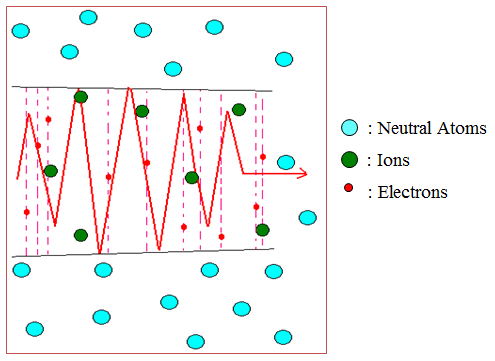 | Figure 1. Schematic view of the ionized particles of gas by laser pulse |
 | (3) |
 | (4) |
 is electron plasma frequency,
is electron plasma frequency,  is frequency,
is frequency,  is constant number and E is electric field. The relation of ponderomotive force for electron relative ion is as follows:
is constant number and E is electric field. The relation of ponderomotive force for electron relative ion is as follows:  | (5) |
 and
and  are ponderomotive force for ion and electron respectively. Also
are ponderomotive force for ion and electron respectively. Also  is ion mass. Based on the result, the ponderomotive force had poor effect with larger electron mass. The electron density by considering potential
is ion mass. Based on the result, the ponderomotive force had poor effect with larger electron mass. The electron density by considering potential  and electron temperature
and electron temperature  is as follows:
is as follows:  | (6) |
 is electromagnetic wave frequency, electron density is
is electromagnetic wave frequency, electron density is  and critical density
and critical density  is
is  , and laser flux is in order of
, and laser flux is in order of  . According to the initial assumptions, parameter of focal point qatar (d) is 0.8 micrometer and laser pulse length 0.12 micrometer and radiation effects were ignored. The intensity of laser pulse was increased according to the formula
. According to the initial assumptions, parameter of focal point qatar (d) is 0.8 micrometer and laser pulse length 0.12 micrometer and radiation effects were ignored. The intensity of laser pulse was increased according to the formula  where A is number vector potential and
where A is number vector potential and  is base electron mass. Also, intensity of electromagnetic wave (P) is as follows:
is base electron mass. Also, intensity of electromagnetic wave (P) is as follows: | (7) |
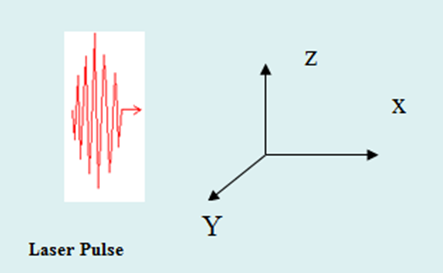 | Figure 2. The geometry of coordinate system for laser pulse |
 | (8) |
 | (9) |
 | (10) |
 is dielectric constant coefficient. The electric field in plasma is as follows:
is dielectric constant coefficient. The electric field in plasma is as follows:  | (11) |
 | (12) |
 | (13) |
 and
and  were assumed zero as the result electron speed is zero in y and z direction for wave propagation in z direction. So
were assumed zero as the result electron speed is zero in y and z direction for wave propagation in z direction. So  and
and  .
. | (14) |
 and
and  are electric filed in x direction and magnetic field in y direction respectively and
are electric filed in x direction and magnetic field in y direction respectively and  is electron speed in x direction. For electric field in plasma, differential equation is as follows:
is electron speed in x direction. For electric field in plasma, differential equation is as follows: | (15) |
 | (16) |
 | (17) |
 is electron pressure. The mean ponderomotive potential
is electron pressure. The mean ponderomotive potential  is as follows:
is as follows: | (18) |
 | (19) |
 | (20) |
 | (21) |
 and
and  is dielectric tensor that calculated for isotropic magnetic plasma. Using first order approximation, the motion equation is as follows:
is dielectric tensor that calculated for isotropic magnetic plasma. Using first order approximation, the motion equation is as follows:  | (22) |
 | (23) |
 is base magnetic field and
is base magnetic field and  is base electron density. When
is base electron density. When  is as follows:
is as follows: | (24) |
 | (25) |
 | (26) |
 | (27) |
 | (28) |
 | (29) |
 | (30) |
 is discarded, the relation is as follows:
is discarded, the relation is as follows: | (31) |
 | (32) |
 | (33) |
 | (34) |
 when magnetic and electric filed are zero
when magnetic and electric filed are zero  . Nonlinear differential equation of electromagnetic field in plasma is as follows:
. Nonlinear differential equation of electromagnetic field in plasma is as follows:  | (35) |
 | (36) |
 | (37) |
 | (38) |
 and relation is as follows:
and relation is as follows:  | (39) |
 . The electric constant is as follows:
. The electric constant is as follows:  | (40) |
 is cyclotron frequency and
is cyclotron frequency and  is refractive index of material. So
is refractive index of material. So  ,
,  and
and  and the change of
and the change of  is always positive.
is always positive.  | (41) |
 | (42) |
 | (43) |
 | (44) |
 and
and  where
where  is velocity of electron temperature. If the free mean time of electron is small, the first letter of left side is ignored and electron temperature is finally obtained as follows:
is velocity of electron temperature. If the free mean time of electron is small, the first letter of left side is ignored and electron temperature is finally obtained as follows: | (45) |
 | (46) |
 | (47) |
 | (48) |
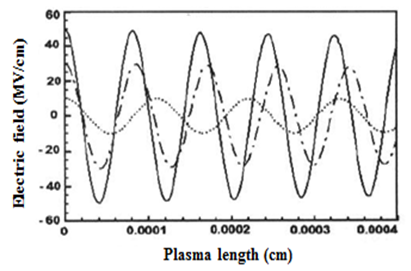 | Figure 3. Changes in electric field as the function of plasma length (Z) for intensity of various laser pulses  |
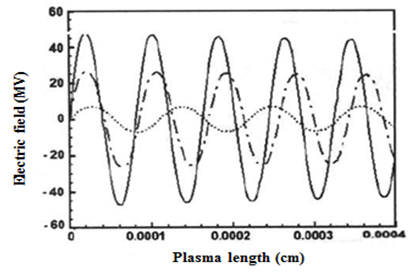 | Figure 4. Changes in electric field as the function of plasma length (Z) for intensity of various laser pulses  |
 The critical density, base electron density and electron temperature are as follows:
The critical density, base electron density and electron temperature are as follows: The change of electron density ratio
The change of electron density ratio  is shown as the function of plasma length (Z) for intensity of various laser pulses (Fig. 5). Based on the results, the oscillation of electron density is strongly increased by increasing of laser pulse intensity in plasma.
is shown as the function of plasma length (Z) for intensity of various laser pulses (Fig. 5). Based on the results, the oscillation of electron density is strongly increased by increasing of laser pulse intensity in plasma.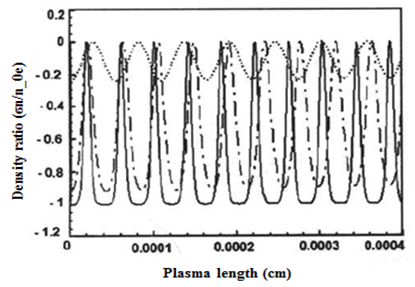 | Figure 5. Changes in electron density ratio as the function of plasma length (Z) for intensity of various laser pulses  |
 The critical density, base electron density and electron temperature are as follows:
The critical density, base electron density and electron temperature are as follows: The change of electric field is shown as function of plasma length (Z) for various magnetic fields (Fig. 6). Based on the result, the wavelength oscillation of electric field is had little change by increasing of magnetic field in plasma.
The change of electric field is shown as function of plasma length (Z) for various magnetic fields (Fig. 6). Based on the result, the wavelength oscillation of electric field is had little change by increasing of magnetic field in plasma. 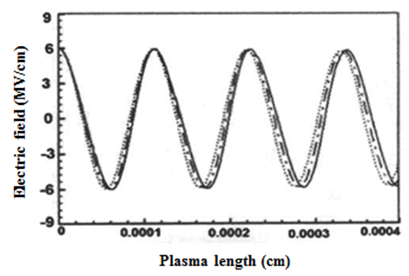 | Figure 6. Changes in electric field as the function of plasma length (Z) for various magnetic fields  |
 The magnetic field is as follows:
The magnetic field is as follows:  The critical density, base electron density and electron temperature are as follows:
The critical density, base electron density and electron temperature are as follows: The change of magnetic field is shown as the function of plasma length (Z) for various magnetic fields (Fig. 7). Based on the result, the longitudinal section of magnetic field and the wavelength oscillation of magnetic field are increased a little in constant laser pulse intensity.
The change of magnetic field is shown as the function of plasma length (Z) for various magnetic fields (Fig. 7). Based on the result, the longitudinal section of magnetic field and the wavelength oscillation of magnetic field are increased a little in constant laser pulse intensity.  | Figure 7. Changes in magnetic field as the function of plasma length (Z) for various magnetic fields  |
 The magnetic field is as follows:
The magnetic field is as follows:  The critical density, base electron density and electron temperature are as follows:
The critical density, base electron density and electron temperature are as follows: The change of electron density ratio is shown as the function of plasma length (Z) for various magnetic fields (Fig. 8) and the oscillation of electron density is increased.
The change of electron density ratio is shown as the function of plasma length (Z) for various magnetic fields (Fig. 8) and the oscillation of electron density is increased. 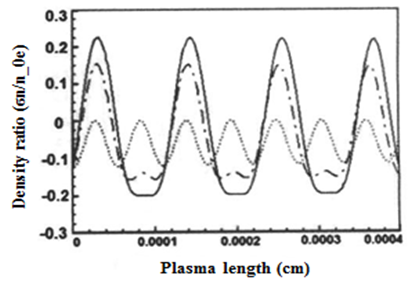 | Figure 8. Changes in electron density ratio  as the function of plasma length (Z) for various magnetic fields as the function of plasma length (Z) for various magnetic fields  |
 The magnetic field is as follows:
The magnetic field is as follows:  The critical density, base electron density and electron temperature are as follows:
The critical density, base electron density and electron temperature are as follows: The change of electric field is shown as the function of plasma length (Z) for various electron temperatures (Fig. 9) and the wavelength oscillation of electron temperature is decreased.
The change of electric field is shown as the function of plasma length (Z) for various electron temperatures (Fig. 9) and the wavelength oscillation of electron temperature is decreased.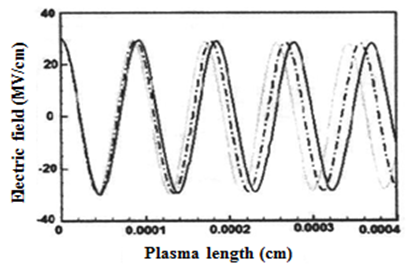 | Figure 9. Changes in electric field as the function of plasma length (Z) for electron various temperatures  |
 The electron temperature is as follows:
The electron temperature is as follows:  The critical density and base electron density are as follows:
The critical density and base electron density are as follows: The change of electric field is shown as the function of plasma length (Z) (Fig. 10) and the oscillation of electric field is increased.
The change of electric field is shown as the function of plasma length (Z) (Fig. 10) and the oscillation of electric field is increased.  | Figure 10. Changes in electric field as the function of plasma length (Z).  |
 The change of magnetic field is shown as the function of plasma length (Z) for electron various temperatures (Fig. 11) and the longitudinal section of magnetic field and the ratio of effective magnetic field are increased.
The change of magnetic field is shown as the function of plasma length (Z) for electron various temperatures (Fig. 11) and the longitudinal section of magnetic field and the ratio of effective magnetic field are increased.  | Figure 11. Changes in magnetic field as the function of plasma length (Z) for electron various temperatures  |
 The electron temperature is as follows:
The electron temperature is as follows:  The critical density and base electron density are as follows:
The critical density and base electron density are as follows: The change of magnetic field is shown as the function of plasma length (Z) (Fig. 12) and the oscillation of magnetic field is increased.
The change of magnetic field is shown as the function of plasma length (Z) (Fig. 12) and the oscillation of magnetic field is increased. 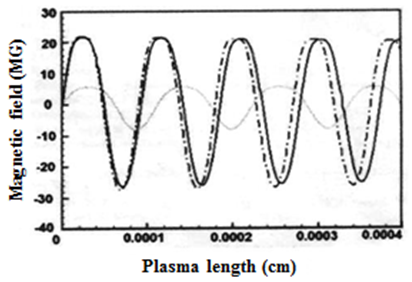 | Figure 12. Changes in magnetic field as the function of plasma length (Z).  |
 The change of electron density ratio is shown as the function of plasma length (Z) for electron various temperatures (Fig. 13). Based on the result, the electron density is decreased since electric constant is increased.
The change of electron density ratio is shown as the function of plasma length (Z) for electron various temperatures (Fig. 13). Based on the result, the electron density is decreased since electric constant is increased. 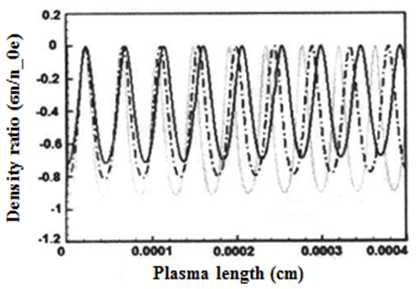 | Figure 13. Changes in electron density ratio as the function of plasma length (Z) for electron various temperatures  |
 The electron temperature is as follows:
The electron temperature is as follows:  The critical density and base electron density are as follows:
The critical density and base electron density are as follows:
3. Result and Discussion
- The theoretical pattern was studied for interaction of underdense plasma. Based on the results, interaction of high intensity laser pulse is strongly nonlinear equation and there is no analytical solution. The fourth method of Runge-Kutta and MATLAB programming language were used to solve the equation in the numerical form. The interaction of high intensity laser pulse was decreased oscillation wavelength. The increase of laser pulse intensity was resulted to the increase of oscillation, the decrease of electron density, and the increase of electric constant. The oscillation wavelength of plasma was reduced by the decrease of electron density. And the electron wavelength was decreased by the increase of electric constant. The longitudinal section of field was shown nonlinear and non-sinusoidal because of the current increase of laser energy. The laser pulse intensity and electron density were increased as the function of plasma length along the z axis in images.The laser pulse duration is greater than plasma thickness therefore the increase of dielectric constant is caused the decrease of electron density in plasma. This physical subject is increased size of magnetic and electric field oscillations. Also the changes of laser pulse intensity are caused the increase of electron density oscillations, temperature and magnetic influence. Based on the physical phenomenon, the created ohmic changes are caused the decrease of the electron wavelength that this subject is increased length section of magnetic electric and field for non-sinusoidal and nonlinear. In this article
 , and radiation effect of laser pulse is ignored on ions via consideration of created ohmic heating by the interaction of laser and plasma. The Maxwell's, hydrodynamics, energy equations are indicated that oscillation wavelength of electric field, wavelength of electron temperature oscillation domain and oscillation domain of magnetic influence is reduced.
, and radiation effect of laser pulse is ignored on ions via consideration of created ohmic heating by the interaction of laser and plasma. The Maxwell's, hydrodynamics, energy equations are indicated that oscillation wavelength of electric field, wavelength of electron temperature oscillation domain and oscillation domain of magnetic influence is reduced. 4. Conclusions
- In this study, high intensity laser interaction with underdense plasma was investigated by Maxwell's and hydrodynamic equations, ponderomotive force, electron ohmic heating, the longitudinal section in the electric and magnetic field, oscillation and density of electron. The oscillation wavelength of the longitudinal section was decreased and the oscillation was increased. The increase of intensity of laser pulse was strongly peaked the effective magnetic permeability, temperature and electron density oscillation because of the nonlinear ohmic heating effect. At same time, the wavelength was simultaneously decreased. In length section of electric and magnetic field, the oscillation wavelength was reduced but oscillation expansion was increased. The increase of intensity of laser pulse was dramatically increased density, temperature and effective magnetic permeability for electron in plasma. Also they were reduced because of the ohmic heating effect of the field.
 Abstract
Abstract Reference
Reference Full-Text PDF
Full-Text PDF Full-text HTML
Full-text HTML